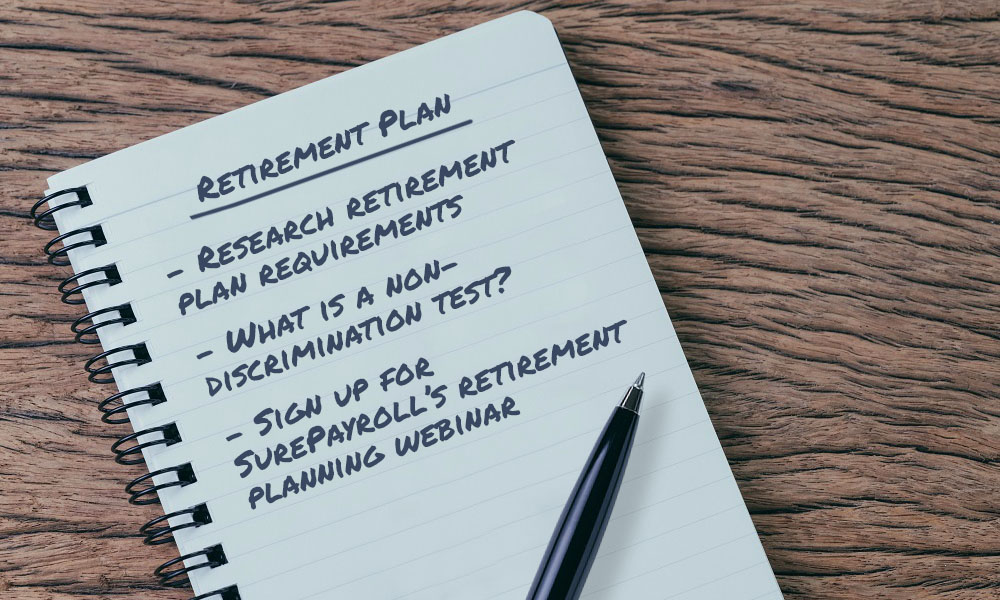The Payroll Blog
News, tips, and advice for small business owners
- Home
- Resources
- Payroll Blog
- Breaking Down the Retirement Plan Testing Barrier
Breaking Down the Retirement Plan Testing Barrier
We’ve previously covered that many Americans in the workforce are facing a retirement crisis—they aren’t prepared to retire and don’t know how to get there. With the Safe Harbor 401(k) deadline rapidly approaching, we wanted to revisit some of the most frequently asked questions we hear from small business owners considering offering a retirement plan to their employees.

Establishing a plan comes with a checklist of activities and deadlines, which we will cover in our upcoming webinar, Maximize Your Retirement and Tax Savings in 2018, on Thursday August 16.
In this post, we will discuss the government’s non-discrimination testing requirements.
What is a non-discrimination test and why does it matter?
As a small business owner, you’re likely very familiar with government regulations and requirements, and retirement plans are no exception to that oversight. For the purposes of this post, we will specifically be focusing on requirements for 401(k) plans.
When you offer a 401(k) plan to your employees, the government wants to check that it’s being done fairly and ethically. Because a 401(k) plan offers substantial tax benefits, the government wants to make sure that these plans do not solely benefit company owners and the highest compensated employees. To see if plans are compliant, the government performs a non-discrimination test by reviewing the plan you offer. The IRS is looking to see that all of your employees are treated fairly in terms of the plan you offer, and to ensure that every eligible employee is able to contribute should they want to.
If your plan has a low adoption rate and/or savings rates among your employees, these can be red flags to the IRS and cause them to look into your plan further. While most businesses do pass this test, the IRS may require you to change your plan slightly in order to get that passing grade.
How to get a passing grade
While nobody wants to fail, sometimes it does happen. One study showed that almost 60,000 companies failed their non-discrimination testing in 2014. This guide from the IRS can help you if you do fail, and it also provides tips to help you avoid mistakes the following year.
Don’t want the hassle of testing?
If you’re concerned about the time and resources involved in executing a non-discrimination test, you do have an option: a safe harbor 401(k) plan allows you to bypass the testing requirement.
The difference with the safe harbor 401(k) is that you are offering a match or employer contribution to each eligible employee. When an employee invests in their 401(k), you as a small business owner will offer a percentage (match), and give that exact same percentage to every single employee who chooses to invest. You could also choose instead to provide an employer contribution, given to all eligible employees regardless of their election to contribute to the plan. By offering either of these incentives, you effectively prove that your plan is fair and equitable.
Next Steps
Are you looking for more information on 401(k) plans and to better understand safe harbor? You can sign up here for our free webinar, Maximize Your Retirement and Tax Savings in 2018, scheduled for Thursday August 16.
Related Blog Posts
View Our Plans and Pricing
Small Business Is Our Business.
This website contains articles posted for informational and educational value. SurePayroll is not responsible for information contained within any of these materials. Any opinions expressed within materials are not necessarily the opinion of, or supported by, SurePayroll. The information in these materials should not be considered legal or accounting advice, and it should not substitute for legal, accounting, and other professional advice where the facts and circumstances warrant. If you require legal or accounting advice or need other professional assistance, you should always consult your licensed attorney, accountant or other tax professional to discuss your particular facts, circumstances and business needs.


